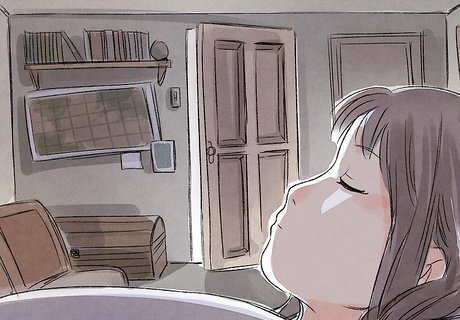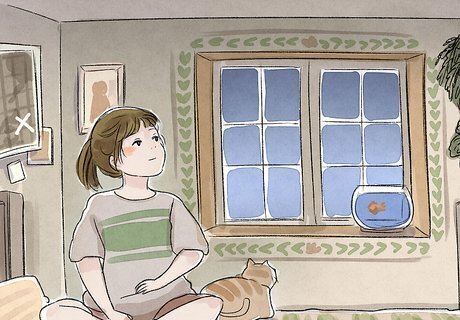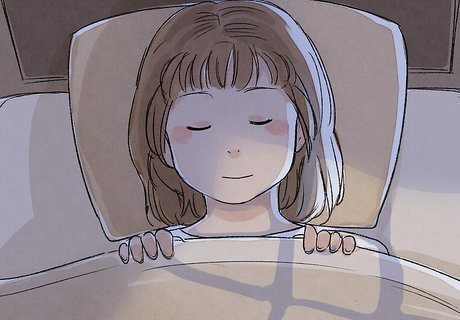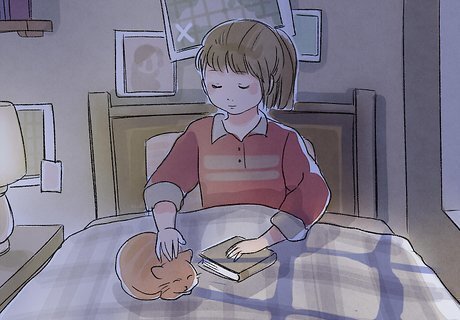
views
Preparing for Bed

Calm down before bed. One way to help yourself get over your fear of the dark is to make sure to give yourself enough time to wind down before you go to bed. You’ll need to work on shutting off all electronic devices at least half an hour before bed, avoiding caffeine after noon or so, and doing something nice and relaxing, whether you read for a little while or listen to some soft music. Getting yourself in the most restful mindset possible can help you ease the anxiety you feel when the lights turn out. Try 10 minutes of meditation. Sit down and focus on the breath rising in and out of your body as you relax your body parts, one at a time. Focus on thinking about your body and breath only and banishing all anxious thoughts from your mind. Find a groove that works for you. It can be drinking chamomile tea, listening to classical music, or cuddling with your cat. Avoid doing anything that will make you more afraid or anxious, such as watching the nightly news or a violent television show. You should also avoid anything that will be likely to stress you out and make you more worried at night in general, such as last-minute homework or a serious conversation.

Gradually wean yourself off of light. You don’t need to shut off all of your lights at once to get over your fear of the dark. First, you should know that sleeping in darkness leads to a deeper, more restful sleep than sleeping with the lights on. Use this as a jumping off point to encourage yourself to sleep in darkness. If you sleep with all the lights on because of your fear, you can start off by dimming the lights a little before you go to bed, or even shutting off some of the lights if you wake up in the middle of the night. This can help you slowly get used to sleeping in darkness. You can set a goal for yourself, like deciding that you’d be okay with sleeping with just a nightlight, or only with having another light on in the other room.

Challenge your fears. When you get into bed at night, ask yourself what you’re really afraid of. If you think there’s someone in your closet, under your bed, or even hiding behind a chair in the corner of your room, then you should go and check that place. Show yourself that there’s absolutely nothing to see and nothing to be worried about. If you do this, you’ll be proud of yourself for facing your fears and will be able to sleep more at ease. If, for example, you find that bumps, thumps, and other noises in the night spark fear, you can try using a white noise machine or an app that plays natural sounds to counter the unknown noises in your living space. If you wake up with this fear in the middle of the night, tell yourself that the sooner you check on it, the sooner you’ll feel better. Don’t spend all night worrying about the unknown.

Leave a bit of light on if you need it. Don’t be ashamed of using a nightlight or dimmable, low-level LED bulbs, both of which provide light that is conducive to sleep. If this really does ease your fears and make you feel less scared, then you shouldn’t feel like you have to do away with it completely to stop being scared. Besides, having a nightlight on in the hall, or having a light on in the other room, can help you get around more easily if you wake up and have to go to the bathroom. Plenty of people sleep with a bit of light on. Don't think that you need to sleep in total darkness to deal with your fear of the dark.

Make your room more inviting. Another way you can face your fears it to make sure that your room is a comforting, inviting place for you to sleep in. Keep it nice and neat so there is less fear that there’s something hiding under a pile of clothes or in a messy closet. Aim to have warm, bright colors in your room so it has a more peaceful and positive energy. Don’t overcrowd your room with furniture or keepsakes, or you’ll feel suffocated. If you work to create a more positive atmosphere in your room, you’ll be more likely to feel safe there. Hang up pictures that make you feel safe and comforted. If you hang up scenes that are dark, mysterious, or even threatening, then they may be making you more afraid without you realizing it. Making your room more inviting can also just make your room a place where you want to spend more time. The goal is to feel safe and happy in your room instead of afraid.

Learn to sleep on your own. If you’re afraid of the dark, then you may want to sleep in the same bed as your parents, your siblings, or even with your dog. However, if you really want to get over that fear, then you have to learn to see your bed as a safe place that you’re capable of staying in by yourself. If you’re used to sleepovers with your parents or siblings, work on spending half the night with them and weaning yourself away from sleeping with a buddy little by little. If you have a pet dog or cat, they can be a great source of comfort, and having them in the bed with you can help ease your fears. But with that said, you shouldn’t depend on them being in the bed forever. Having them sleeping at your feet or in the room should be enough.
Adjusting Your Perspective

Change your ideas about darkness. One of the reasons you may be afraid of the dark is because you feel that darkness is evil, awful, darkly mysterious, chaotic, or any other number of negative things. However, if you want to start embracing the darkness, you have to work on forming positive associations with it. You can think of it as calming, cleansing, or even comforting like a thick, velvet blanket. Work on changing your perception of the dark, and you’ll soon be able to embrace it. Write down all of the things you associate with darkness. As silly as it may sound, you should cross them out or tear up this piece of paper. Then, you should write down new, more positive associations. If this feels too corny, you can say it aloud instead.

Think of your bed as a safe place. People who are afraid of the dark are usually afraid of their beds, because they think of them as a place that makes them vulnerable to harm. If you want to change your perspective about the dark, then you have to think of your bed as a source of comfort and protection. Look at it as a place where you look forward to being, not a place you dread. Use comfortable blankets and spend time relaxing in your bed, doing things that make you more eager to sleep in the bed at night. Spend more time reading and feeling at home in your bed. This will help you feel happy to be there at night.

Don’t be ashamed about your fear. Many adults have admitted to being afraid of the dark. No matter what age you are, there’s no need to be embarrassed about your fears; everyone has one fear or another, and you should be proud of yourself for being honest and open about yours. Instead, feel proud of yourself for admitting that you have a fear and that you want to take steps to tackle it. In fact, one study showed that up to 40% of adults admitted to having some kind of fear of the dark. The more open you are about your feelings, the sooner you’ll be able to tackle them.

Tell other people about it. Talking openly to other people about your fear can help you feel more support and comfort as you try to get over it. Also, talking about it may lead you to find that other people share your fear and you may even get some good advice in the process. Furthermore, opening up about your fear of the dark may lead you to feel some relief, instead of bottling up all of your feelings. Your friends will be supportive about your fear and you don't need to worry that they will judge you if they're your real friends.

Get help if you need it. The truth is, it’s not always possible to fully tackle a fear, though you can take measures to make it more bearable. However, if you feel that your fear of the dark is completely debilitating, leading you to lose sleep, and making your life pretty unbearable, then it may be time to seek professional help to discuss your anxieties and their larger implications. Remember that you should never be shy about asking for help. You can talk to your doctor about your fear and discuss whether it is truly debilitating; he may recommend medication or the best course of action. You’ll also be able to get at the root of any deeper anxieties that may be contributing to your fear.
Helping Your Child Get Over a Fear of the Dark

Don’t play into the fear. If you want to help your child get over a fear of the dark, then you have to show them that there’s no such thing as monsters under their bed or scary men in their closet. Don’t humor them and say, “Let me make sure there are no monsters in the closet tonight!” Instead, make it clear that it’s impossible for any monsters to ever be in the closet at all. This can help your child see that the fear is irrational. If you play into the fear, then your children will think that there really is a chance that a monster or bad guy can be in the darkness a different night. You may think that this may be helping your child in the short term, but really, it’ll only be confirming their fears. You won’t always be there to “check under the bed” for your child; instead, you teach them to check for themselves. This will help them learn to refute the fear on their own, and eventually master it.

Make sure your child has a soothing bedtime routine. Another way to help your child get over a fear of the dark is making sure that the child’s bedtime routine is relaxing and soothing. Make sure you have reading time before bed, avoid giving your child late-night soda or sugary treats, and help your child avoid seeing anything disturbing on the news or a late-night program that could get their imagination moving in the wrong direction. The more relaxed your children are before they go to bed, the less anxious they’ll feel about the dark. Help your child take a warm bath or talk about relaxing topics instead of things that make your child excited. If you have a kitty, spend some time petting your favorite critter with your child so he can calm down. Work on softening your voice and speaking less emphatically. Slow down the pace of things to help get your child ready for sleep. Read a bedtime story that has a happy, positive outcome. Start dimming the lights.

Talk to your child about the fear. Make sure you really listen to your child and hear what it is that’s actually scaring him; it could be a general fear of darkness, or it can be a fear of an intruder, for example. The more you know about what’s scaring your child, the more easily you’ll be able to treat the problem. Besides, your child will feel better after talking to you about the problem. Make sure your child isn’t ashamed of the fear. When your child is talking, make it crystal clear that there’s nothing to be ashamed about, and that everyone has fears. Help your child get creative about conquering their fears. Let them give it a name and then think of different stories and methods where they can conquer it. Help your child act out a battle with their fear that lets them feel victorious in the end.

Reinforce your child’s safety and comfort. Make sure that your child feels safe and comfortable not just before going to bed, but throughout the day. Though the fact of the matter is, you won’t always be there to protect your children 100% of the time, you can still make an effort to make them feel safe and comforted. Repeat how much you love them, how you’re there for them, and make it clear that your home is safe from harm. This can help your children let go of their fears of the dark. Allow secure objects in your child’s bed and room. If your child wants his favorite blanket or a nightlight, that’s okay. Don’t think that the child needs total darkness and no blanket to conquer his fears.

Make your child see that bed is a safe place. Your child should look at his bed as a place of comfort and safety, not a place that causes anxiety. Read books to your child in bed and make sure he or she has positive associations with it as much as you can. Just try not to spend too much time in the bed yourself, so that your child feels as comfortable and safe there as possible. Though it’s natural for you to want to protect your child, it’s more important that you give him the tools he needs to feel safe on his own in the long run. Don’t do sleepovers. Though you may think letting your child sleep in your bed can bring him comfort, this is only temporary. Encourage your child to sleep in his own bed because he’ll have to get used to it eventually.

Seek help if it’s needed. Sometimes, there may only be so much you can do to help your child get over a fear of the dark. If your child is frequently wetting the bed, waking up screaming with nightmares, or demonstrating larger anxieties and fears about other aspects of his life regularly, then seeing a doctor can help you locate and treat the sources of your child’s fears and anxieties. Don’t just assume that your child will grow out of it, and work to really give him the help he needs. If you think this is a serious problem, then the longer you wait, the more difficult it will be for your child to overcome it.
Reader Suggested Remedies

Try to go to bed early. Going to bed late may make you more afraid. You will probably feel more comfortable going to bed while your parents are still awake. Besides, you need to get enough sleep to stay awake at school or work the next day.
Use clothing to help you. Here are some ideas: Get a glow in the dark shirt. While it may sound silly, this shirt lights up before you go to bed, and then gradually lights off. Plus, it's cool. Remember the masks you wore at the spa? Try purchasing one of those and sleeping in it, it may seem uncomfortable at first but you'll get used to it. It helps your eyes not dart around the room seeing shadows and anything else.

Use humor. When you are feeling scared try to see the funny things that happen in your life or about something you saw or read, like if someone runs in to a glass door and they get back up look around and walk into it again and then open the door. If you're scared, try to think of funny things that happen in your day or during the week. Use several nightlights in your room. One little nightlight certainly does not light up a room enough for someone who's very afraid of the dark. You can even get a colorful lava lamp that you can leave on all night.Cope with Your Fear of the Dark Step 2.jpg Around Christmas time, if your family puts Christmas lights/decorations outside your house, or lights around the window frames, leave your curtains or blinds open. The lights from the decorations might shed extra light in your room.Cope with Your Fear of the Dark Step 8.jpg Keep a pocket light near so it's easier to check things out if you feel scared.

Use sound. Sound can be a good way to get rid of your fear of the dark. For example: Put on a sound machine/air conditioner, then your don't hear all the creepy noises. Listen to music. If possible, play classical, soft or any relaxing music on a stereo or computer all night. If you use Windows Media Player, you can even play a relaxing animation to go with your music, and it casts more light in your room.Cope with Your Fear of the Dark Step 3.jpg

Play games or watch funny videos on your phone before dozing off. A lot of teenagers lie in bed using their phones at night. If you're afraid of the dark, watching funny videos on YouTube will make you smile and keep your mind off what scares you.

Talk to your parents or older siblings about your fear. Telling people makes you feel a lot better, and they may be able to give you useful advice.

Sleep near or with others. For example: Have "sleepovers" with a sibling. On weekends especially, it can be fun to have a sibling sleep in your room. You can laugh and watch funny videos together. Don't be embarrassed! It's comforting when someone is with you.Cope with Your Fear of the Dark Step 6.jpg Sleep with a pet. If you have a cat or dog, having them in your bed next to you can be very comforting. Sleeping with a family pet will reassure you that you are safe. They will let you know if they hear or sense anything, especially bad things.Cope with Your Fear of the Dark Step 7.jpg Sleep with lots of stuffed toys or stuffed animals.

















Comments
0 comment